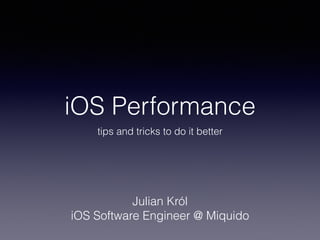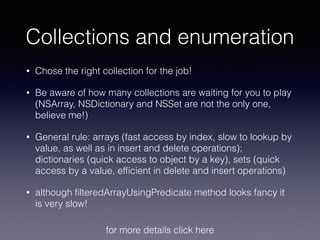iOS performance: tips and tricks to do it better
- 1. iOS Performance tips and tricks to do it better Julian KrĂłl iOS Software Engineer @ Miquido
- 2. Overview âą We get more powerful devices but create more complex apps âą We want to keep UI highly responsive âą Present valuable content ASAP
- 3. â Ralph Marston (http://www.brainyquote.com) âDon't lower your expectations to meet your performance. Raise your level of performance to meet your expectations.â
- 4. Most general Avoid blocking main thread whenever it is possible, put the hard computing to background and on the man thread update UI ! dispatch_async(dispatch_get_global_queue(DISPATCH_QUEUE_PRIORITY_DEFAULT, 0), ^{ //work to be done in background (for example data parsing or retrieving) dispatch_async(dispatch_get_main_queue(), ^{ //updating UI when the expensive work is ïŹnished on the background thread }); }); !
- 5. reuseIdentiïŹer Probably everyone knows that but for clarity: - (UITableViewCell *)tableView:(UITableView *)tableView cellForRowAtIndexPath:(NSIndexPath *)indexPath { static NSString *MyIdentiïŹer = @"CellIdentiïŹer"; JKMyCell *cell = [tableView dequeueReusableCellWithIdentiïŹer:MyIdentiïŹer]; //if cell was not created so far then initialise it if (!cell) { cell = [[NSBundle mainBundle] loadNibNamed:@"JKMyCell" owner:nil options:nil][0]; } //in other case only update - do not allocate it every time! JKModelObject *obj = [self getObjectAtIndexPath:indexPath];// retrieving model object to update cell [cell update:obj]; //update cell every time it gets called to the view return cell; }
- 6. Creation & Caching âą avoid recreation of big and slow objects, example: NSDateFormatter and re-setting its format âą create (reusable) objects once and reuse whenever possible (a few date formatters depending on number of date formats)
- 7. Collections and enumeration âą Chose the right collection for the job! âą Be aware of how many collections are waiting for you to play (NSArray, NSDictionary and NSSet are not the only one, believe me!) âą General rule: arrays (fast access by index, slow to lookup by value, as well as in insert and delete operations); dictionaries (quick access to object by a key), sets (quick access by a value, efïŹcient in delete and insert operations) âą although ïŹlteredArrayUsingPredicate method looks fancy it is very slow! for more details click here
- 8. Shadows - common mistake âą Do not add shadows in that way: view.layer.shadowOffset = CGSizeMake(1.f, 1.f); view.layer.shadowRadius = 10.f; âą Use bezier path instead: view.layer.shadowPath = [[UIBezierPath bezierPathWithRect:view.bounds] CGPath]; Not convinced? Checked it with cells in UITableView while fast scrolling :)
- 9. Images - general rules ! âą while adding images existing on device use UIImage imageNamed: rather than UIImage imageWithContentsOfFile - ïŹrst one uses caching! âą [UIColor colorWithPatternImage:] - ïŹne as long as image is relatively small comparing to the surface it will fulïŹl otherwise use UIImageView which corresponds to the image size âą use placeholder while loading (in the background!) content from the web
- 10. Network communication âą again(!), do not block main thread! âą Try some external libraries (AFNetworking highly recommended) âą avoid synchronous calls âą cache responses if it make sense to avoid reloading it
- 11. @autoreleasepool âą the whole app is in one âą in most cases you can avoid creating many temporary objects âą if you can not, consider @autoreleasepool (example later on)
- 12. Other notices âą - (BOOL)application:(UIApplication *)application didFinishLaunchingWithOptions:(NSDictionary *)launchOptions - do not use it to initialise the whole world, âą most of the objects, managers etc can wait with its initialisation till the very ïŹrst usage âą accessing ivars is a bit faster than properties (I personally avoid properties) âą handle memory warning situations âą in most cases any delegate should be weak - avoid retail cycle counts
- 13. PROFILER!! For improvement testing as well as looking for bottlenecks use proïŹler which is provided with Xcode Most useful: ! âą allocations âą time proïŹler âą leaks
- 14. Itâs time for a short demo about measuring performance improvement with Xcode's proïŹler
- 15. Sources and inspirations âą http://www.raywenderlich.com/31166/25-ios- app-performance-tips-tricks âą http://www.objc.io/issue-7/collections.html





![reuseIdentiïŹer
Probably everyone knows that but for clarity:
- (UITableViewCell *)tableView:(UITableView *)tableView cellForRowAtIndexPath:(NSIndexPath *)indexPath {
static NSString *MyIdentiïŹer = @"CellIdentiïŹer";
JKMyCell *cell = [tableView dequeueReusableCellWithIdentiïŹer:MyIdentiïŹer];
//if cell was not created so far then initialise it
if (!cell) {
cell = [[NSBundle mainBundle] loadNibNamed:@"JKMyCell" owner:nil options:nil][0];
}
//in other case only update - do not allocate it every time!
JKModelObject *obj = [self getObjectAtIndexPath:indexPath];// retrieving model object to update cell
[cell update:obj]; //update cell every time it gets called to the view
return cell;
}](https://image.slidesharecdn.com/iosperformance-140330142809-phpapp01/85/iOS-performance-tips-and-tricks-to-do-it-better-5-320.jpg)


![Shadows - common mistake
âą Do not add shadows in that way:
view.layer.shadowOffset = CGSizeMake(1.f, 1.f);
view.layer.shadowRadius = 10.f;
âą Use bezier path instead:
view.layer.shadowPath = [[UIBezierPath bezierPathWithRect:view.bounds] CGPath];
Not convinced? Checked it with cells in UITableView
while fast scrolling :)](https://image.slidesharecdn.com/iosperformance-140330142809-phpapp01/85/iOS-performance-tips-and-tricks-to-do-it-better-8-320.jpg)
![Images - general rules
!
âą while adding images existing on device use UIImage
imageNamed: rather than UIImage
imageWithContentsOfFile - ïŹrst one uses caching!
âą [UIColor colorWithPatternImage:] - ïŹne as long as image
is relatively small comparing to the surface it will fulïŹl
otherwise use UIImageView which corresponds to the
image size
âą use placeholder while loading (in the background!)
content from the web](https://image.slidesharecdn.com/iosperformance-140330142809-phpapp01/85/iOS-performance-tips-and-tricks-to-do-it-better-9-320.jpg)






